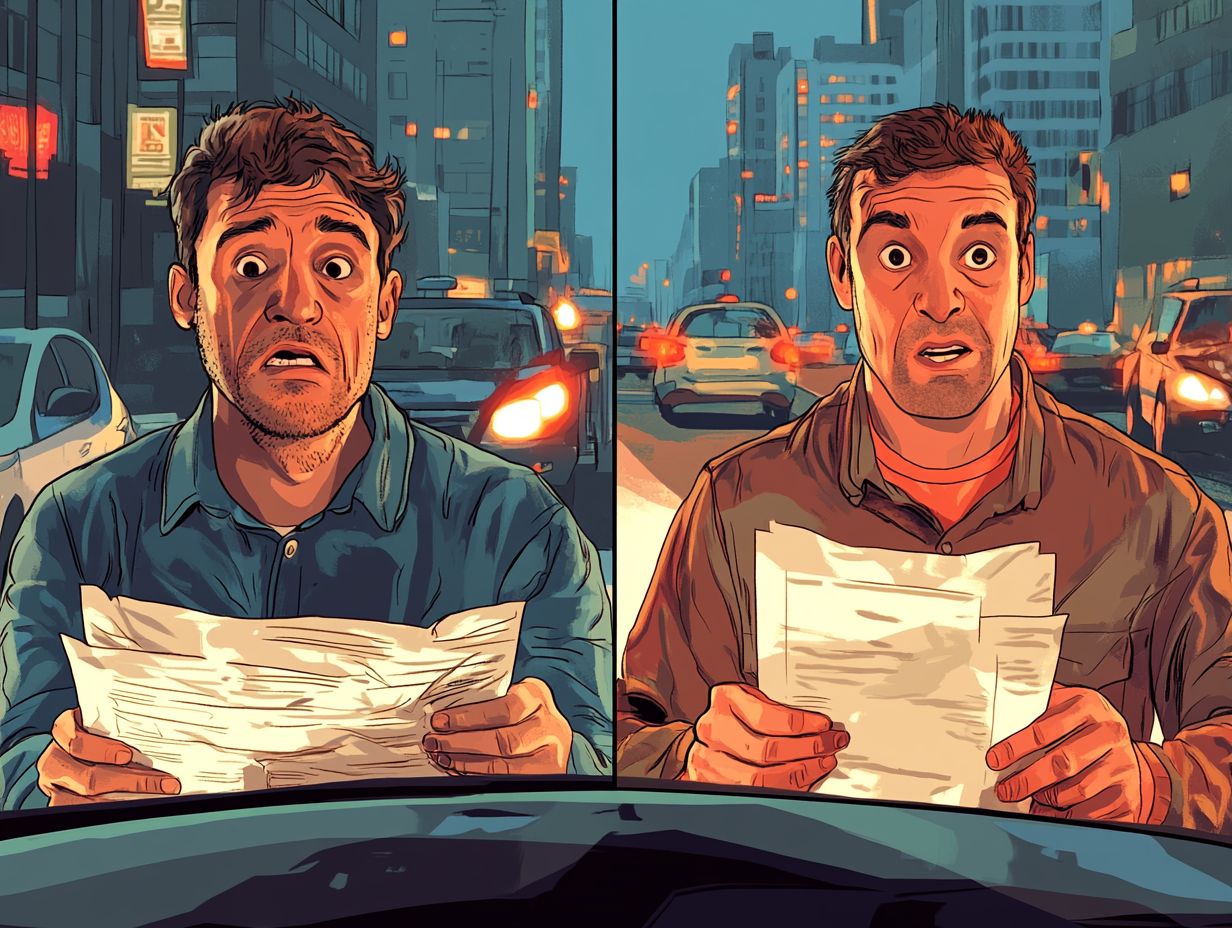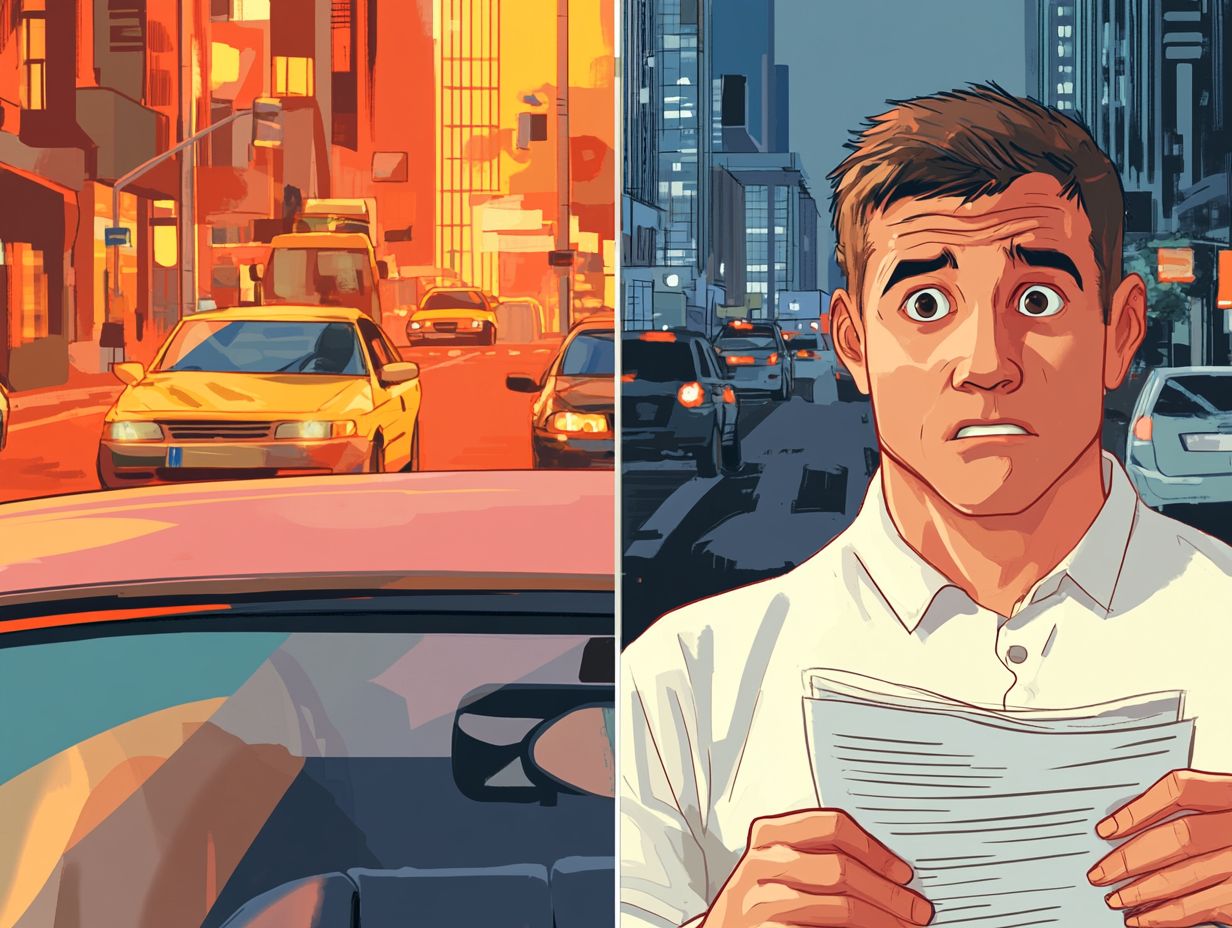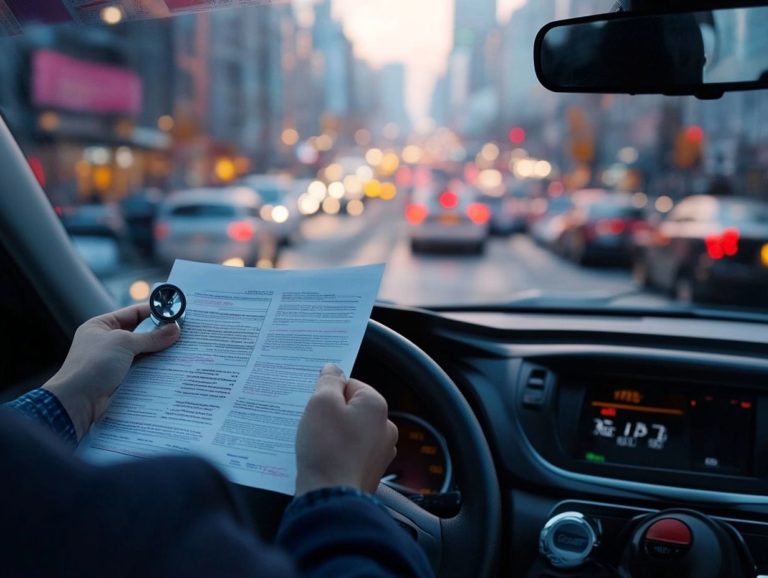Uninsured vs. Underinsured Motorist Coverage Explained
Driving on the road comes with risks, including the chance of encountering an uninsured or underinsured driver. Understanding how uninsured and underinsured motorist coverage works is vital for safeguarding yourself and your finances in these situations.
This article clarifies the definitions and distinctions between these coverage types, explains their importance, and guides you through the claims process. It will also assist you in evaluating your needs and considering alternatives to ensure you re adequately covered.
Get ready to drive with confidence your peace of mind starts now.
Contents
- Key Takeaways:
- Understanding Uninsured and Underinsured Motorist Coverage
- Why You Need Uninsured and Underinsured Motorist Coverage
- How Uninsured and Underinsured Motorist Coverage Works
- Factors to Consider When Choosing Coverage Limits
- Alternatives to Uninsured and Underinsured Motorist Coverage
- Frequently Asked Questions
- What is the difference between uninsured and underinsured motorist coverage?
- Do I need both uninsured and underinsured motorist coverage?
- How does uninsured motorist coverage work?
- What does underinsured motorist coverage cover?
- Do I need uninsured or underinsured motorist coverage if I have health insurance?
- Is uninsured or underinsured motorist coverage expensive?
Key Takeaways:

- Uninsured and underinsured motorist coverage protects you in case of an accident with a driver who lacks insurance or has insufficient coverage.
- This coverage is crucial for safeguarding your assets from potential financial burdens caused by uninsured or underinsured drivers.
- When choosing coverage limits, consider your personal needs and risks, such as the value of your vehicle and potential medical expenses.
Understanding Uninsured and Underinsured Motorist Coverage
Understanding uninsured motorist coverage is essential for drivers seeking comprehensive financial protection against unexpected accidents, especially when other motorists fall short on their insurance.
In states like Arizona, specific laws govern these coverage types and their relationship with auto insurance policies. This can significantly affect your medical expenses, liability for property damage, and bodily injury claims.
Knowing how these policies work is key to ensuring that you are well-protected in the event of a car accident.
Definitions and Differences
Uninsured motorist coverage acts as your safety net when you re in an accident with a driver who lacks insurance that covers damages you cause to others. Conversely, underinsured motorist coverage applies when the at-fault driver’s insurance doesn t fully cover your medical costs and property damage.
Both types of coverage play crucial roles in protecting your finances, especially in unfortunate situations where other drivers can’t meet their financial obligations. Companies like Progressive offer these coverages to help you navigate the aftermath of accidents.
When you file a claim, having either type of coverage can significantly influence the compensation you receive, ensuring you aren t burdened with escalating expenses due to someone else’s negligence.
Understanding these coverages empowers you to make informed decisions about your insurance needs, ultimately enhancing road safety for everyone.
Why You Need Uninsured and Underinsured Motorist Coverage
Having uninsured and underinsured motorist coverage is essential for protecting your financial future. In the unpredictable world of driving, accidents can happen with reckless or uninsured drivers, including those involved in hit-and-run incidents.
Without this coverage, you could face staggering medical expenses and property damage costs. It s crucial to understand the auto insurance requirements specific to your state to ensure you have the right level of protection.
Evaluate your coverage today or consult an expert for personalized advice!
Protecting Yourself from Other Drivers

By obtaining uninsured motorist coverage, you effectively shield yourself from the financial fallout of accidents caused by drivers who lack adequate insurance. It covers your medical expenses and personal injury claims, even in the most challenging situations.
This type of coverage serves as a vital safety net for you. It complements collision coverage by filling in the gaps in liability. Accidents happen. If the at-fault driver has no insurance, the financial stress can be overwhelming. The financial burden can escalate quickly, impacting not just your medical bills but also your lost wages and other related costs. Uninsured motorist coverage helps ease that stress, allowing you to concentrate on your recovery instead of wrestling with complicated claims.
It also strengthens the legal framework surrounding personal injury claims, enabling a more thorough approach to compensation. This way, you won t be left to shoulder the consequences of someone else’s negligence.
How Uninsured and Underinsured Motorist Coverage Works
Uninsured and underinsured motorist coverage is a vital component of your auto insurance policy. It offers you financial protection by covering certain expenses linked to bodily injury and property damage when the at-fault driver lacks adequate insurance.
It’s crucial for you to grasp the coverage limits outlined in your policy, particularly in light of Arizona laws. These regulations determine the amount you can claim in the unfortunate event of an accident.
Coverage Limits and Claims Process
Knowing your coverage limits is essential for your peace of mind! They dictate the maximum compensation you can receive from your uninsured or underinsured motorist coverage during the claims process with your insurance company. This process may also involve specific deductible amounts that need to be met before coverage kicks in.
To evaluate these limits, carefully review your policy to ensure they align with your financial needs and potential risks. When an incident occurs, filing a claim can feel overwhelming. You must gather all necessary documentation, such as police reports and medical bills, to bolster your case.
The insurance company will conduct an investigation, assessing damages and confirming the specifics of your coverage. Their role is to streamline the process, providing guidance and ensuring that all claims are addressed fairly and efficiently.
By understanding each of these components, you can significantly influence the outcome of your claims experience.
Factors to Consider When Choosing Coverage Limits
When selecting coverage limits for uninsured and underinsured motorist coverage, it’s essential to carefully assess your personal needs and risks. This ensures you choose limits that offer sufficient financial protection, tailored specifically to your unique circumstances and lifestyle.
Consider aspects like your driving habits, the area you live in, and your overall risk exposure as you navigate this important decision.
Evaluating Your Personal Needs and Risks

Evaluating your personal needs and risks is essential when determining the right uninsured and underinsured motorist coverage limits. This assessment ensures your auto insurance requirements align seamlessly with your lifestyle and financial protection goals.
To conduct this evaluation effectively, start by reflecting on your driving habits. Do you often navigate heavy traffic, or do you primarily embark on long-distance journeys? Consider how frequently you commute and whether you find yourself in high-risk situations, such as driving at night or in adverse weather conditions.
Take a moment to assess any past incidents or close calls; these experiences can provide valuable insights into your potential vulnerabilities. Additionally, factor in the demographics of your driving area, the prevalence of uninsured drivers, and the safety features of your vehicle. By incorporating these considerations, you’ll gain a clearer understanding of the coverage limits that are most suitable for you.
Alternatives to Uninsured and Underinsured Motorist Coverage
While uninsured and underinsured motorist coverage is essential, you might also want to explore alternatives within auto insurance that provide varying levels of protection.
Consider collision coverage and more comprehensive liability options. These options can significantly contribute to safeguarding you against financial loss in the event of an accident.
Other Types of Insurance Coverage to Consider
Look into other types of insurance coverage that can enhance your financial safety. Collision coverage pays for vehicle repairs after an accident, while liability coverage protects you against claims for bodily injury or property damage to others. Together, these options play a significant role in your overall protection.
Comprehensive coverage is also important. This addition covers non-collision-related incidents, such as theft or vandalism, ensuring that you’re not solely reliant on uninsured or underinsured motorist coverage.
Personal injury protection (PIP) is another crucial element, as it covers medical expenses and lost wages, no matter who is at fault. Using these different insurance options helps you build a strong insurance plan that provides peace of mind on the road.
With this level of coverage, you ll feel ready to tackle any risks on the road, knowing your financial well-being is well protected.
Frequently Asked Questions
What is the difference between uninsured and underinsured motorist coverage?

Uninsured motorist coverage protects you if you are in an accident with a driver who does not have insurance. Underinsured motorist coverage protects you if the other driver’s insurance is not enough to cover all of your damages.
Do I need both uninsured and underinsured motorist coverage?
You don t have to have both, but having them is smart. Having both coverages gives you the most protection in case of an accident with an uninsured or underinsured driver.
How does uninsured motorist coverage work?
If you are in an accident with an uninsured driver, your uninsured motorist coverage will pay for your medical bills, lost wages, and other damages up to the limit of your policy.
What does underinsured motorist coverage cover?
Underinsured motorist coverage will cover the difference between the other driver’s insurance limit and the total cost of your damages, up to the limit of your policy.
Do I need uninsured or underinsured motorist coverage if I have health insurance?
While your health insurance may cover some medical expenses, uninsured and underinsured motorist coverage helps cover other damages, such as lost wages and pain and suffering.
Is uninsured or underinsured motorist coverage expensive?
The cost of these coverages varies depending on your insurance company and your policy limits. It is typically not very expensive, and the protection it provides can be well worth the cost in case of an accident.
Explore your insurance options today to ensure you have the best coverage!






